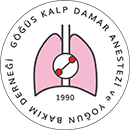

Volume: 25 Issue: 2 - 2019
| 1. | Cover Page I (796 accesses) |
| 2. | Contents Pages II - V (1132 accesses) |
| 3. | Publication Policies and Writing Guide Pages VI - XI (690 accesses) |
| REVIEW | |
| 4. | Biomarkers in the detection of acute renal failure associated with cardiac surgery Emel Gündüz, Tülin Aydoğdu Titiz doi: 10.5222/GKDAD.2019.63497 Pages 79 - 88 (1291 accesses) Acute renal injury (CSA-AKI) associated with cardiac surgery is about 30% and is the second most common cause of AKI. AKI; increased morbidity, mortality and hospital stay. The incidence of CSA-AKI varies depending on the definition of AKI, RIFLE, AKIN and the latest Kidney Disease: Improving Global Outcomes (KDIGO) criteria are defined and is used today. In the etiopathogenesis of CSA-AKI; exogenous and endogenous toxins, metabolic anomalies, ischemia-reperfusion injury, inflammation and oxidative stress. Many times these etiological factors, not alone, increase the risk of hemodynamic instability during perioperative period, microcirculatory dysfunction, pump flow during cardiopulmonary bypass and perfusion pressure, hypothermia, hemodilution and transfusion. It is also associated with the patient preoperatively; There are several factors that increase the risk of CSA-AKI. The interaction of surgical method and patient-related factors leads to a decrease in renal function in these patients. More sensitive parameters are needed due to the limitations of urine output and serum creatinine levels used in the measurement of renal function. Therefore, Cystatin C, which is thought to be a marker of renal function, was initially used for early detection of post-operative AKI, but no clear evidence has yet been found. Recently; More sensitive and early detectable biomarkers such as Interleukin-18 (IL-18), Neutrophil Gelatinase-Associated Lipocalin (NGAL), Insulin-like Growth Factor-Binding Protein 7 (IGFBP7) and Tissue Inhibitor Metallproteinases 2 (TIMP-2); There are literature data indicating that both CSA-AKI and generally AKI can be used for detection. |
| RESEARCH ARTICLE | |
| 5. | Risk Factors for Sepsis Following Congenital Heart Surgery Yasemin Yavuz, Nurgul Yurtseven, Numan Ali Aydemir, Oktay Korun, Serap Şimşek-Yavuz doi: 10.5222/GKDAD.2019.99815 Pages 89 - 95 (936 accesses) INTRODUCTION: This study aims to evaluate the incidence of sepsis and risk factors associated with sepsis in pediatric patients who underwent congenital heart surgery. METHODS: 289patients were prospectively enrolled in this study. Patients were divided into two groups according to the Society of Critical Care Medicine (SSCM) diagnostic criteria as GroupI including 28 patients who fulfilled the criteria for sepsis and GroupII including 261 patients who were not diagnosed to have sepsis. Demographic information, type of operation, complexity, duration of preoperative hospitalization(>5 days) and intensive care unit(ICU) stay, requirements of mechanical ventilation(MV), history of pulmonary hypertension(PHT), and requirements of emergency surgery, total cardiopulmonary bypass(CPB) and aortic cross-clamp(ACC) times. During the postoperative period delayed sternal closure, duration of MV, the need for reintubation, and need for reoperation were also recorded. RESULTS: The incidence of sepsis was %4.74. The mortality rate in septic patients was 32%. Factors associated with sepsis were younger age, low body weight, duration of preoperative hospitalization and ICU stay, preoperative requirement of MV, palliative and emergency surgery, history of PHT, prolonged MV, reintubation, and reoperation. Multivariate analysis identified reintubation and duration of MV as the major risk factors for sepsis DISCUSSION AND CONCLUSION: Serious infectious problems, such as sepsis, are encountered due to inadequate development of immune resistance mechanisms in pediatric patients. Appropriate preoperative preparation of patients for surgery, reducing the length of stay in the hospital and in the ICU, and reducing the need for reintubation by extubation of the patients for an optimal period, would reduce the mortality rate due to sepsis. |
| 6. | Comparison of The Effects of Percutaneous Catheter Insertion with Anatomic Landmark or Ultrasonography Guided Techniques on Hospital Cost in Children Yahya Yıldız doi: 10.5222/GKDAD.2019.03880 Pages 96 - 101 (1022 accesses) INTRODUCTION: Insertion of a central venous catheter and an arterial catheter in children involves difficulties because the vessel diameter is small. With catheterization time and material saving by ultrasonography, the success of the procedure increased and the complications decreased. The aim of this study was to investigate the methods of insertion of central venous catheter and artery in the presence of anatomical signs and ultrasonography; time, material, surgery, atrial catheter insertion aspects of comparison. METHODS: After obtaining hospital ethics committee approval, using prospective, case-controlled, first year anatomical signs (Group A, n = 151) and second year ultrasonography (Group B, n = 151) guidance methods in 1-year period catheter insertion into the superior vena cava and / or arteries in patients less than 10 kg, were included in the study. RESULTS: In Group A and Group B, the total time of insertion of central venous catheter was 78 hours, 37 hours and 41 hours, respectively (p <0.005). In Group A and Group B, total arterial catheter insertion time was 96 hours, 63 hours and the difference was 33 hours, respectively (p <0.005). The total number of catheters used was 203 in Group A, 167 in Group B and 36 in Group B. The use of surgical set for catheterization was 9 (Group A: 8 sets, Group B: 1 set) (p <0.05). Total catheterization times (operating room hourly usage price is 3.200 TL), the catheter and surgical set used in the same number of cases in the two groups taken into account a net improvement of TL 241.620 was achieved. DISCUSSION AND CONCLUSION: Ultrasonography guided central venous catheter and arterial catheter placement were performed in a significantly shorter time compared to the anatomical sign. Less material was used in the cannulations performed by ultrasonography. Due to the reduction in hospital costs, the use of ultrasonography should be considered in especially low-weighted children. |
| 7. | Transfusion In Pediatric Heart Surgery: Prospective, Observational Study Feride Karacaer, Ebru Biricik, murat türkeün ılgınel, demet lafli tunay, MEHMET ŞAH TOPÇUOĞLU doi: 10.5222/GKDAD.2019.78300 Pages 102 - 112 (1554 accesses) INTRODUCTION: Transfusion of blood and blood products may be unavoidable in pediatric patients undergoing cardiac surgery. The aim of this study was to determine the factors and risks associated with transfusion in these patients. METHODS: Preoperative demographic data, duration of cardiopulmonary bypass (CPB) and operation time were recorded. At the beginning of CPB, during the CPB and at the end of the operation hematocrit and hemoglobin values were recorded. The lowest body temperature during CPB, intraoperative crystalloid, colloid, blood, blood products consumptions were recorded. The consumption of blood and blood products, length of stay intensive care unit (ICU) and hospital, and mortality were recorded during the postoperative period. RESULTS: 83 children were included in the study. Intraoperative erythrocyte transfusion was higher in patients with RACHS1: 3 than in patients with RACHS1: 2 (p=0.009). There was a negative correlation between age and postoperative erythrocyte, total erythrocyte and total fresh frozen plasma (FFP) transfusion. There was a positive correlation between CPB duration and intraoperative erythrocyte and FFP, postoperative erythrocyte, FFP, cryoprecipitate consumption, total erythrocyte and total FFP consumption. The intraoperative erythrocyte and FFP consumption, the postoperative cryoprecipitate consumption were higher in cyanotic children (Erythrocyte p=0.002; FFP p=0.002, cryoprecipitate p=0.026). 15 patients died. Postoperative erthrocyte and FFP, total erythrocyte and FFP consumption were higher in the patients who died (total erythrocyte p=0.001, total FFP p=0.003). DISCUSSION AND CONCLUSION: Amount of transfusion were related to age, RACHS1, CPB duration, body temperature, cyanosis in children undergoing open heart surgery. Erthrocyte and FFP transfusions were higher in the patients who died. |
| 8. | Newly Developed Major Neurological Injury After Open Heart Surgery Şerife Gökbulut Bektaş, Mine Altınkaya Çavuş, Aslı Demir doi: 10.5222/GKDAD.2019.18291 Pages 113 - 118 (3600 accesses) INTRODUCTION: Neurological injury is one of the most serious complications of cardiac surgery. In this study, we aimed to evaluate patients who had postoperative type 1 neurological injury after open heart surgery in the last two years in our center. METHODS: In our hospital, 2689 patients underwent open heart surgery in the last two years 50 patients with obvious neurological damage were detected postoperatively. The data of these patients were obtained from by electronic database and files scanning from the archive. RESULTS: Fifty patients who achieved the data were evaluated. The mean age of the patients was 60,4 ± 10,2 years. 61,2% of the patients had hypertension and 22,4% had accompanied by diabetes. Procedures applied to the patients were 54% coronary bypass surgery, 20% multiple surgical procedures and 14% aortic surgery. The mean duration of CPB was 131,1 ± 58,6 min. Accordingly, in the etiology cerebrovascular event,while ischemic stroke caused by emboli was observed in 90%, hypoperfusion related stroke was observed in 10% patients. Permanent damage after SVO occurred in 56% of patients. Mortalite was observed in 17 patients(34%). DISCUSSION AND CONCLUSION: In our study, the rate of obvious neurological injury after open heart surgery was 1,9% in our hospital. A large range of 0,5-5,4% is given in the literature. We think that intraoperative embolic factors are more involved in the etiology of neurological injury in our patients. |
| 9. | Assessment of the results of early and medium-term of mitral valve repairs Fikri Mehmet Yapıcı doi: 10.5222/GKDAD.2019.57442 Pages 119 - 125 (1671 accesses) INTRODUCTION: To determine short and mid-term results of different techniques on patients who underwent mitral valve repair annuloplasty surgery in a span of 15 years in our hospital. METHODS: 262 patients who underwent mitral valve repair were included in the study. The effects of different repair techniques (Kay, Wooler, Bayazıt shir (drawstring), ring annuloplasty techniques, papillary muscle repair and cordaplasty), in early and medium period, on the clinical and echocardiographic results were investigated. RESULTS: 67% of the patients were female (n = 177) and the mean age was 31.2±12 (5-64). Etiologically, 74% of the cases were rheumatic, 18% had endocarditis and 14% suffered from degenerative valvular disease. Hospital mortality rate was 4,2% with 11 cases. The patients were followed up for 1189 patient years. The rate of reoperation was 1.5% / patient year, the incidence of thromboembolism was 2.3% (0.5% / patient year), and one patient had hemorrhage due to anticoagulant (0.08% / patient year). The 5-year survival rate of the patients were 88±3%. 8 patients who underwent mitral repair had successful pregnancies and gave birth. DISCUSSION AND CONCLUSION: Different mitral repair techniques did not show any significant difference in terms of early-mid-term mortality, reoperation, and thromboembolism (p> 0.05). There was no difference in the comparison of patients with and without annuloplasty ring (p = 0,092). Mitral valve repair, due to its good early and mid-term results, as well as low hospital mortality rates, should be considered and utilized on patients in rheumatic disease group and patients in the period of fertility. |
| 10. | Postoperative renal damage in heart surgery Mine Altınkaya Çavuş, Şerife Gökbulut Bektaş, Aslı Demir doi: 10.5222/GKDAD.2019.29200 Pages 126 - 132 (1099 accesses) INTRODUCTION: Cardiac surgery involves complicated pathophysiologic conditions, which are followed by many important complications. Renal failure, the most important complication, is responsible for increased morbidity and mortality. METHODS: The files of the patients who underwent 2600 open heart surgeries in our hospital between 2016-2018 were retrospectively reviewed. RESULTS: Postoperative renal failure developed in 105 of 2600 patients undergoing open heart surgery. DISCUSSION AND CONCLUSION: Renal failure is associated; male sex, diabetes and peripheral vascular disease, previous myocardial infarction, poor ejection fraction (<50%), anemia, contrast agent exposure, nonsteroidal anti-inflammatory drugs (NSAIDs) and antihypertensive drugs, prolonged cardiopulmonary bypass (CPB). |
| CASE REPORT | |
| 11. | Very rare malposition of a central venous catheter into the left internal mammary vein in patient with coronary artery disease Elif Coşkun, Levent Altınay, Rahşan Dilek Okyay, Anıl Tekin, Ufuk Tütün doi: 10.5222/GKDAD.2019.53824 Pages 133 - 136 (1108 accesses) Central venous catheterization is an interventional technique which is commonly used for helping diagnose ant treatment in hospitalized patients, also may lead to complications that malposition and rupture. In this article, we wanted to evaluate a very rare catheter malposition to left internal mammarian vein during coronary arteries bypass greft operation. Although unexpected catheterization into the left internal mammary vein has been reported in the literature. This case seems to be the first report to malposition detected intraoperatively in coronary artery disease |
| 12. | Complete Rupture Of Right Main Bronchus Characterized by Expanded Lung: A Case Report Hıdır Esme, Hasan Doğan doi: 10.5222/GKDAD.2019.15238 Pages 137 - 140 (1319 accesses) A 17-year-old male patient was admitted to our hospital with history of blunt trauma over chest (run over by a tractor). Patient was first attended at a peripheral hospital where he was intubated with single lumen endotracheal tube and given assisted mechanical ventilation. Intercostal drains were put on right and left side of chest. There were massive subcutaneous emphysema, pneumomediastinum and pneumothorax in left lung on chest X-ray. Fiber-optic bronchoscopy was performed. At the carina level, it was seen that the right main bronchus was completely ruptured from the trachea. Patient was planned for immediate thoracotomy. The rupture was repaired of a primary. On the seventh postoperative day, there was incomplet expansion of the left lung. The patient was reoperated. Necrotic tissues and hematoma in upper lobe of left lung were cleared. In this case, we emphasized that bronchoscopy is the most important procedure in the diagnosis of tracheobronchial injury. |
| 13. | New member to join the family of vasopressors in septic shock: methylene blue (dual case report) Şerife Gökbulut Bektaş, Mine Altınkaya Çavuş doi: 10.5222/GKDAD.2019.42103 Pages 141 - 144 (3294 accesses) Background: Sepsis is a serious medical condition that progresses to organ damage in response to infection. As a major cause of death in the world, it continues to be the subject of research and discussion in intensive care. Treatment includes rapid recognition, resuscitation, hemodynamic support, control of the source of infection and early antibiotic therapy. Hemodynamic support; noradrenalin with strong evidence. Case presentation: Patients with sepric shock; The tissue needed for perfusion was taking high-dose vasopressor medication to ensure arterial values of blood pressure. Treatment with methylene blue was beneficial in reducing high drug doses. Conclusions: Methylene blue used in many types of shock; Although side effects are seen, noradrenaline in septic shock is an agent that can be a future competitor. When the cost is very important; We believe that this drug, which is more suitable, will find the deserved importance. |

















